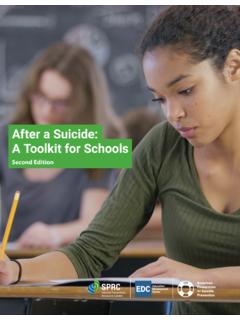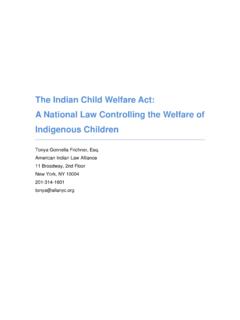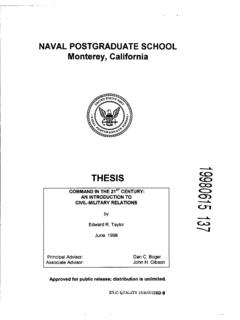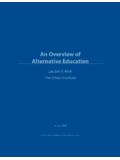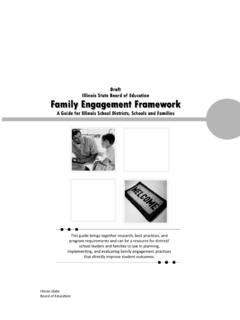Transcription of PIEDMONT CAREER ACADEMY page 1 Appendix A1: …
1 PIEDMONT CAREER ACADEMY page 1 Appendix A1: Evidence of Educational Need Alia Wong, author of Where Are All the High-School Grads Going? (The Atlantic, January 11, 2016) writes, Recently-released numbers out of the National Student Clearinghouse Research Center suggest that college-enrollment rates have actually decreased and for the fourth straight year, all despite massive increases in federal aid for students who can t afford tuition. In May 2013, McKinsey & Company, in collaboration with Chegg, Inc., released the Voice of the Graduate report. Among their findings are several further indicators of reluctance to enter college right out of high school, which are reflected in the topics of growing conversations among Person County students, educators, parents, and business leaders: a) Nearly half of all graduates from four-year colleges say they are in jobs that don t require a four- year degree.
2 B) About one in three graduates do not feel that college prepared them well for the world of work. c) Four in ten graduates of the nation s top 100 colleges couldn t get jobs in their chosen fields. d) Almost six times as many graduates are working in retail or hospitality as originally desired to. e) The rising cost of college and the debt many students and families are expected to incur are raising questions in some quarters about the value of college as an investment. Except for those who find themselves unemployed and un-enrolled in any kind of higher education, those high school graduates who don t go to four-year colleges and universities generally fall into three categories, which make up PIEDMONT CAREER ACADEMY s Targeted Student Population: - those who attend community colleges and trade schools; - those who go into the military; and - those who go directly into the workforce.
3 It is reasonable to assume that a significant number of those who fall into these three categories are at-risk students and those identified as Exceptional, the two categories with the most historic difficulty in reaching high school graduation. Research shows us that a great many of these students can also be categorized as economically disadvantaged. Alia Wong addresses this phenomenon as well: Based on US Census Bureau figures, the percentage of students from low-income families attending college immediately after getting their high-school diplomas has declined by 10 percentage points since 2008, to 46%. One of the primary recommendations of the Voice of the Graduate report reads, Education leaders could.
4 Develop meaningful alternative paths for students who might not fully benefit from a four-year degree. PIEDMONT CAREER ACADEMY seeks to serve the students who fall into the three categories listed above. We believe that these students should be afforded access to the same innovation, flexibility, and targeted instructional strategies which are enjoyed by so many students in the large number of college-prep charter schools around the state. Statistics and analysis provided by the July, 2017 Economic Overview Report of the Person County Economic Development Commission support the need for the placement of a vocational / CAREER themed secondary school in Person County.
5 According to the report, US and NC census figures put the median age of Person County s population of slightly more than 39,000 at , compared to for the state of North Carolina and for the USA. The largest percentage of the county s residents fall in the under 18 years category ( ); the second-largest percentage are in the 45-54 years category ( ). The county is white, black, with all other racial groups together totaling less than 10%. These numbers line up very closely with those of the state s population as a whole, except that Person County s African-American population is higher than North Carolina s total percentage. PIEDMONT CAREER ACADEMY page 2 Appendix A1: Evidence of Educational Need The median household income in Person County, however, is $42,105, compared to the state s median of $46,868 and the nation s median of $53,889.
6 Person County s poverty level is nearly 20% in comparison to the state rate of and the national rate of In addition, the county has higher percentages of residents with high school diplomas, some college, and two-year associate s degrees. However, Person County has a significantly lower percentage of residents with bachelor s degrees ( vs. and , respectively) or with post-graduate degrees ( vs. and , respectively). The evidence is therefore clear: Person County residents, the largest demographic group of which are currently school-age students, tend to complete two-year college and trade school programs at a significantly higher rate than they complete four-year college/university degrees.
7 If these rates hold constant over the next two decades, the demand for employment in jobs requiring less than a bachelor s degree among Person County high school graduates will continue to rise. In April 2017, the seasonally adjusted unemployment rate for Person County was , down from at the same time the previous year. This year s lower rate, however, as has been true in the past, was again higher than the national rate of The largest employment sectors in Person County are Manufacturing and Retail Trade, both at The second-largest employment sector is Health Care and Social Assistance, at With the exception of the county s few physicians and employees in the highly-skilled careers of the Health Care sector, all three of these sectors employ high percentages of people with lower attained education levels than university bachelor s degrees.
8 The county s high location quotients, defined in the EDC report as sectors in which a region has high concentrations of employment compared to the national average, are Production Occupations and Installation, Maintenance, and Repair Occupations, both of which are also major employers of those with high school diplomas or associate s degrees only. Regional sectors with the best job growth (or most moderate job losses) over the last five years are Accommodation and Food Services, Health Care and Social Assistance, and Retail Trade (Economic Overview: Person County 90-Minute Drive Time). The 2016 report of the same regional statistics named Manufacturing, Administrative and Support, Waste Management and Remediation Services, and Other Services as leading job growth sectors for this area of the state.
9 All are major employers of workers with less than four-year degrees. The largest major occupation group in Person County is Office and Administrative Support Occupations, followed by Sales and Related Occupations and Production Occupations. Over the next ten years, the highest replacement demand (occupation demand due to retirements and workers moving from one occupation to another) in Person County and surrounding areas is expected in Sales and Related Occupations and in Food Preparation and Serving Related Occupations. All of these occupation groups and sectors provide employment to large numbers of workers with high school diplomas and associate s degrees as their highest levels of formal education.
10 In terms of Industry Clusters, defined by the EDC report as geographic concentrations of interrelated industries or occupations, the highest relative concentration in Person County is Coal-Oil-Power, another group of occupations not requiring bachelor s degrees or higher for most employees. Expected growth rate for occupations requiring a 2-year degree or certificate in Person County over the next ten years is per year, one of only two areas by required education and training expected to grow during this time (the other being occupations requiring a postgraduate degree, at per year). A clear picture emerges from these statistics: Person County s job growth, job prospects, and job requirements run toward a high percentage of workers who will not require formal higher education to be employed or to maintain employment over the next decade.










